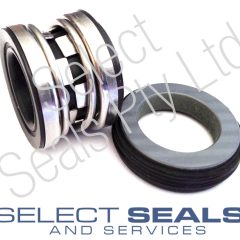Progressive Cavity Pumps & Wastewater Sealing

SOME IMPORTANT questions about the advantages of progressive capacity pumps and what types of mechanical seals are used in wastewater applications are dealt within this article.
Q: What are the advantages of a progressive cavity pump?
A: A single screw pump is a type of rotary pump known as a progressing cavity pump. The single screw construction of the pump and positive displacement pumping method lend this type of pump to a wide range of applications.
Progressing cavity pumps have a rotor with external threads and a stator with internal threads
In the simplest form of progressing cavity pump, a single-threaded inner member (rotor) rotates inside a double-threaded outer member (stator). The geometry of the rotor and stator are such that cavities are created between the rotor and stator.
In each revolution of the rotor, two cavities are formed that progress from one end of the rotor and stator pair to the other end. In most progressing cavity pumps, the stator is made of an elastomeric material while the rotor is made of a rigid material.
Progressing cavity pumps are also available with rigid stators that fit on the rotor with a clearance.
Advantages of progressing cavity pumps are found in the wide variety of fluids, flow rates and pressures they can serve. This is a highly diverse classification of pumps.
For example, they are capable of pumping liquids that range from less than 1 centistoke (cSt) viscosity to more than 430,000 cSt viscosity.
They can handle fluids containing abrasives and solid particles up to 9 centimeters (3.5 inches) in diameter and can handle multiphase fluids with up to 99 percent gas.
They are capable of self-priming and can suction lift fluids up to 8.5 meters (28 feet).
They can be used to pump practically any fluid that is compatible with the materials of construction.
Some of the smaller progressing cavity pump models operate at speeds up to 1,800 revolutions per minute (rpm), but most industrial pump models operate at speeds from 150 to 600 rpm. The low operating speeds and rotor and stator design enable them to handle delicate and shear-sensitive fluids without causing any damage to the fluid.
Progressing cavity pumps are available with flow rates up to 850 cubic meters per hour (m3/h) (3,750 gallons per minute (gpm)). Standard industrial models are available with differential pressure capabilities up to 70 bar (1,040 pounds per square inch (psi)).
Q: What types of mechanical seals are used in wastewater applications?
A: Mechanical seal technology is continuously progressing and can be applied to almost any pumping application when the right considerations have been addressed. In wastewater applications the two seal arrangements commonly used are single seal (see Figure 3) that can be traditional or split design and dual pressurized (double) seal.

Single pusher seal
Applications for the use of single and dual seals can overlap in a wastewater treatment plant if the right flush plan considerations are made.
When sludge and grit are the services, dual pressurized seals with plan 54 flush can provide reliable operation by reducing the flush water consumptions and ensuring that a suitable clean lubricating fluid is provided to the seal faces (see Figure 4).
Consideration of the additional cost of a dual seal, flush system, and the requirement to reliably operate the flush system need to be considered in the selection and life cycle cost.
Read the full story here





